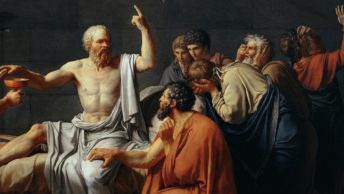The American left is good at coining words and phrases to disguise their intent. “Disparate impact” is one such term. The concept is that some policies in government, law enforcement, public schools, universities and private business affect different racial groups differently, and therefore these policies should be changed to benefit certain minority groups. The goal of advocates of “disparate impact” remedies is to equalize social outcomes instead of creating equal opportunity for all Americans.
Of course, most policies affect groups of people differently. A scholarship program based on academic merit benefits candidates with strong academic records and does not help students who have performed poorly in the classroom. Similarly, a school policy that suspends disruptive students who flagrantly disregard classroom policies affects students differently. Students who follow school rules will not be affected by a suspension policy, while troublemakers will experience more suspensions.
The problem, progressives argue, is that “equal protection under the law” may result in better outcomes for one group (e.g., whites) than for another group (e.g., blacks or Hispanics). The worse outcomes for minorities are often unintentional, but nonetheless should be remedied by policies that give certain minorities a leg up, according to advocates of disparate impact legal theory.
The Impact of Disparate Impact
Under disparate impact theory, equal opportunity under the law, such as race-blind employment, housing and education, is not enough. Intention does not matter; outcomes do.
Disparate impact legal theory, employed most forcefully by the Obama administration, originated in employment and civil rights law, and has since spread its tentacles into many other aspects of American life. The Obama administration’s use of disparate impact theory has been pernicious, infecting criminal justice, school discipline, housing and mortgage lending in addition to employment. Proponents of disparate impact theory argue that racial discrimination, can be inferred without direct evidence of discriminatory intent, if statistics show that blacks or Hispanics or other minority groups are being affected differently from whites on average, compared to their percentage of the population.
This racially divisive legal doctrine stems from Griggs v. Duke Power Company (1971), one of the most important Supreme Court cases in the last half century.The Griggs decision held that if an employer uses a hiring qualification that operates to exclude blacks disproportionately to whites, then the employer can continue to use this requirement only if it can be justified as a matter of “business necessity.”
In subsequent high court decisions, disparate impact theory remained a contentious issue. Stripped of legalistic language, these cases boiled down to the question: Should a finding of racial discrimination be based on intent or outcome? If an employer wishes to require, say, a high school diploma, should a rejected job applicant have the burden of proving that a high school diploma is not necessary for the job, or should the employer have the burden of proving that a high school diploma is a business necessity for the job?
Needless to say, disparate impact analysis complicates the task of filling job openings. A more recent movement to “ban the box” asking job applicants about their criminal history – embraced by the Obama administration based on disparate impact analysis – puts employers in an even more difficult position.
Application to Public Schools
The Obama administration pursued disparate impact theory with a vengeance. Under Attorney General Eric Holder, voting officials, university admission officers, city police forces, consumer agencies, housing authorities and loan officers were instructed to adjust their policies according to disparate impact legal theory. If the outcomes of any policy revealed a disparate racial impact, then officials were instructed to revise their policies to ensure proportionately more equal outcomes.
The consequences of disparate impact theory appear most destructively in public school discipline policy. In an extensive research paper, Gail Heriot and Alison Somin at the University of San Diego Law School examine the social consequences of disparate impact legal policy on public schools across the country.This 72-page report provides distressing evidence that chaos is reigning in many schools, often under protest from teachers, because school administrations have imposed new rules that sharply limit suspension of disruptive students.
Fearful of being charged with racial discrimination, school administrations have implemented policies that often prevent teachers and even principals from suspending students. The result is that students know this, do not fear suspension, and disruptive behavior and violence have increased in many schools. Meanwhile, the majority of students who come to school to learn something are not learning because classrooms have become places of anarchy. Teachers without authority cannot teach; they cannot even maintain a semblance of order in the classroom.
The Obama administration escalated its commitment to disparate impact theory in March 2010 when Secretary of Education Arne Duncan asserted that school suspension policies had created a pipeline from school to prison. Suspended students turned to criminal activity when not in school. These suspended students, and later criminals, were disproportionately African American.
Promising to correct school discipline policy, Duncan directed the Department of Education’s Office for Civil Rights (OCR) to pore over statistical evidence from every school district looking for evidence of racial disparate impact in discipline, specifically evidence that African-American students were disciplined at a higher rate than Asian or white students in a school district. If a school district was shown to have a higher rate of disciplining African Americans, a federal investigation could be launched.
The OCR offered heavy-handed “guidance” to school districts in a letter, the “Dear Colleague” Letter on the Nondiscriminatory Administration of School Discipline, issued jointly with the Department of Justice’s Civil Rights Division. The letter put schools on notice that they were being judged on the “disparate impact” of their disciplinary policy. The letter stated, “Schools also violate Federal law when they evenhandedly implement neutral policies and practices that, although not adopted with the intent to discriminate, nonetheless have an unjustified effect of discriminating against students on the basis of race” (emphasis added). The letter clarified the theory behind federal oversight by concluding, “The resulting discriminatory effect is commonly referred to as ‘disparate.’”
Schools responded accordingly. Wishing to avoid costly investigations, school districts reduced the number of suspensions for minority students.(An OCR investigation might cost up to $50,000 for a school district.) The result was that often black students were given a pass for infractions, while white students experienced a “zero tolerance” policy within their schools.
Intolerable Disorder in Classrooms
Heriot and Somin detailed how after the Obama administration intervention, schools across the country began to have discipline problems as public school administrators undertook to lower suspension rates by overlooking student infractions. A survey of teachers in the Oklahoma City School District showed that 60 percent of teachers in 2015 believed that the amount and frequency of offending behavior of students had increased. One teacher declared, “We were told that referrals [to the principal] would not require suspension unless there was blood. Students who are referred…are seldom taken out of class, even for a talk with an administrator.”
These sentiments were echoed in Indianapolis, where teachers through their union complained about how lenient suspension policies were disrupting their classes. Rhondalyn Cornett, head of the Indianapolis public school teachers union, lamented that she had been flooded with calls and emails from teachers stating that they “don’t feel safe” in their classes.
Similar stories were told about the Lafayette Parish school system in Louisiana. One teacher felt so threatened by a student after he put his hands on her that she threatened to place a restraining order on him. Another teacher testified that he was forced out of the classroom eight times in a single day because of student disruptions, including one student who was dangling another student off a balcony. The student was referred to the principal but was in class the next period.This teacher was fired the day after giving his testimony.
Instead of seeking arrests of juvenile offenders and suspension of disruptive students, schools hired “Cultural Specialists” and “Behavior Specialists” to address the problems of disruption and violence in communities and schools. Most of the evidence of classroom disruption is anecdotal, but there is much of it and is backed up where statistics have been kept.
Backdrop of Florida School Shooting
The February 14 shooting at Marjory Stoneman Douglas High School in Parkland, FL that left 17 students dead at the hands of Nikolas Cruz, a 19-year-old former student at the school, revealed the tragic consequences of hamstringing school discipline in Broward County. In 2013, Broward County, at the urging of the Obama Department of Education, adopted a new program, “PROMISE” (Preventing Recidivism through Opportunities, Mentoring, Intervention, Support and Education). The implementation of this program coincided with a sharp rise in juvenile crime in the county.
Under the program, juvenile offenders, even repeat offenders, were not arrested. Within two years of the implementation of PROMISE, juvenile recidivism surged higher than the state average. As juvenile arrests dropped, serious violent crimes involving youth spiked in the county while falling statewide. After Broward County schools began emphasizing rehabilitation over suspension and incarceration, fights broke out in schools every day in classrooms, cafeterias and hallways. In 2017, 3,000 fights erupted in 300-plus schools across the district.
Nikolas Cruz had been a well-known troublemaker. The move away from arrests even for repeat offenders may help explain why he was able to engage in violence and even bring bullets to school without any arrests or legal consequences. He was finally suspended from Douglas High and placed in another high school, but high schools in Broward County were already places of violence. Of course, Cruz was a troubled and dangerous young man who acted on his own, but his actions occurred in an environment of juvenile violence in Broward County and its schools – facilitated by the Obama administration’s pressure to change school discipline policies because of their disparate impact.
New York City’s Policies Even Worse
New York City collects data each year as part of its schools survey. The Mayor Bill de Blasio administration removed most of the questions about school order from the survey, but some questions remained in the survey to indicate the level of classroom safety. It is clear that de Blasio’s 2015 policy changes – which went well beyond the previous city administration’s orders to end suspensions for first-time, low-level offenses – have encouraged disruption, violence and disorder in the classroom. One of de Blasio’s changes was that principals no longer had the authority to suspend a student without first obtaining written approval from the Office of Safety and Youth Development. While some schools appear to have improved climates, many showed deterioration. This was especially true in heavy minority enrollment schools, where overwhelmingly students and teachers have noted that things have gotten worse. Teachers oppose de Blasio’s policies.
The fatal stabbing of Matthew McCree by Abel Cedeno on September 27, 2017 in New York’s Urban Assembly School for Wildlife Conservation presents a case in point of the breakdown of discipline under de Blasio’s policies. Cedeno, an 18-year-old sophomore, had allegedly been bullied for his sexuality and snapped, stabbing two fellow students.
How to Ruin a School
Five years ago, UA Wildlife was a thriving, safe school. Under founding president Mark Osserheimer and a strict dean of students, Hector Diaz, the school had few problems. At first UA Wildlife resisted de Blasio’s policies, but under a new principal who took office 2014-15, school disciplinary policies were relaxed. Instead of being suspended, disruptive students were placed in a “Warrior Program,” in which if they behaved they were awarded personal lunches and 15-minute passes to leave class to “de-stress.”
When the Warrior Program did not work, it was replaced by the “Positive Behavioral Intervention System,” which offered students tickets for redeemable prices in exchange for good behavior. Student safety deteriorated and the stage was set for a stabbing. Knowing that they could not be suspended, disruptive students began challenging teachers in the classroom and the hallways. Facing unruly students and a hostile administration, many teachers fled.
Have the lax suspension policies forced on schools by government addressed the so-called school-to-prison pipeline? The answer is “No.” Now we have non-suspended disruptive students, who feel empowered to intimidate teachers, principals and fellow students, and they are still ending up going to prison. They have learned that authority in the classroom does not have any meaning, so why should they respect the authority of adults, police on the streets, social workers, youth counselors or anyone?
The Trump administration is challenging Obama-era disparate impact racial policies in schools, consumer loan programs, and public housing mandates. Changes have come in many areas, but shifting bureaucratic priorities and winning in the courts take time. The general public has not heard of disparate impact theory—and might well think the theory is so daffy that nobody would believe in it, except those educated beyond their intelligence. Without public support, reversing established policies is hard.
Meanwhile, we experience yet another example of how the Obama administration encouraged further subversion of authority in our nation.








